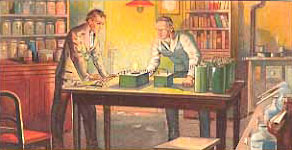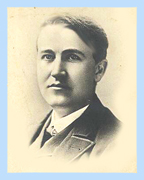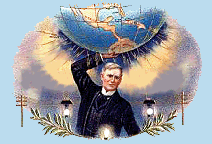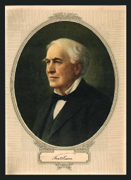
| |
| Home |
| Biography |
| Be Enlightened |
| Gallery |
| Quotes |
|
The Biography of Thomas Edison
|
||||||||||
|
Another By Gerald Beals
Copyright © 1997 All Rights Reserved
"Thomas Edison was more responsible than any one else for creating the modern world. Specifically, no one did more to shape the physical/cultural makeup of present day civilization. Accordingly, he was the most influential figure of the last 500 years: The Heroes Of The Age: Electricity and Man" And TIME MAGAZINE MILLENNIAL Surprisingly, little "Al Edison," who was the last of seven children in his family, did not learn to communicate very well until he was three and a half years of age. Soon thereafter, he suddenly began pleading with every adult he met to explain the workings of just about everything he encountered. If they said they didn't know, he would look them straight in the eyes, with his deeply set and vibrant blue-green eyes and ask them "Why?"
If modern psychology had existed back then, Tom might have been deemed a victim of ADHD (attention deficit hyperactivity disorder) and proscribed a dose of the "miracle drug" Ritalin. Instead, when his beloved mother - whom he often recalled "was the making of me (because) she was so true and so sure of me...and always made me feel I had someone to live for - and whom I must never disappoint - became aware of this situation, she eventually withdrew him from school and tried to home-teach" him. she believed her son's slightly unusual physical appearance and demeanor were merely outward signs of his above-average intelligence. Its also noteworthy to add here that the real contents of a note that Tom's teacher sent home to his mother at this time, informing her that "the child is as dense as a stump and virtually unteachable," was never revealed to him until many years after her death. in any case, "quietly ignoring the its existence and essence, she and her husband utterly dedicated themselves to educating their beloved child by themselves.
Back to www.NancyEdison.com
A proud descendant of the distinguished old Elliot family of New England, New York born Nancy Edison was the devout and charming daughter of a highly respected Presbyterian minister, as well as an accomplished educator in her own right. After the above incident, she commenced teaching her favorite son the "Three R's" and the Bible. Meanwhile, his rather "worldly and roguish" father, Samuel, encouraged him to focus on the great classics, giving him a ten cents reward for each one he completed. It wasn't long thereafter that the serious minded youngster developed a deep interest in world history and English literature. Interestingly, many years later, Tom's abiding fondness for Shakespeare's plays lead him to briefly consider becoming an actor. But, because of his high-pitched voice and extreme shyness before every audience - "except those he was trying to influence into helping him finance ever more inventions" - he soon gave up the idea. Tom especially enjoyed reading and reciting poetry. His life-long favorite was Gray's Elegy In A Country Churchyard. Indeed, his favorite lines "which he seemed to endlessly chant to himself, and anyone within hearing distance" came from its 9th stanza: “The boast of heraldry of pomp and power, All that beauty all that wealth ere gave, Alike await the inevitable hour. The path to glory leads but to the grave...”
At age 11, Tom's parents tried to appease his voracious appetite for knowledge by teaching him how to use the resources of the local library. This skill became the foundation of many factors that gradually caused him to prefer learning via independent self instruction. "Not to be an illiterate hayseed." Starting with the last book on the bottom shelf, Tom now set out to systematically read every book in the stacks. Wisely, however, his parents promptly guided him towards being ever more selective in what he read. So, by age 12, Tom had not only completed Gibbon's Rise And Fall Of The Roman Empire, Sears' History Of The World, and Burton's Anatomy Of Melancholy, he had devoured The World Dictionary of Science and a number of works on Practical Arithmetic and Chemistry. But, in spite of their noble efforts, Tom's dedicated parents soon found themselves incapable of addressing his increasing interest in the Sciences and mathematics. For example, when he began to question them about concepts dealing with Physics and Calculus - such as appear in Isaac Newton's great "Principia" - they were utterly stymied. Accordingly, they eventually scraped enough money together to hire a clever tutor to help their precocious son grasp Newton's complex laws and unique style....
This experience had a few negative affects on the highly impressionable boy. He was so disillusioned by how Newton's sensational theories were written in classical aristocratic terms - which he felt were unnecessarily confusing to the average person - he overreacted and developed a hearty life-long dislike for all such "overly high-tone" language and mathematics.
On the other hand, the simple beauty of Newton's laws did not escape him. In fact, they very much helped him sharpen his own free wheeling style of clear thinking, "proving all things to himself through his own method of objective examination and experimentation." Tom's response to the Principia also enhanced his propensity towards gleaning insights from the writings and activities of other great men and women of wisdom, never forgetting that "even they might be entrenched in preconceived dogma and mired down in error...." All the while, he was cultivating a strong sense of perseverence, readily expending whatever amount of time and perspiration that was needed to overcome any challenge. Which was a characteristic that he later noted was contrary to the way most people respond to stress and strain on their body. The key upshot of this attribute was that his unique mental and physical, stamina stood him in very good stead when he later took on the incredible rigors of a being a successful inventor in the mid-to-late 19th Century. Another factor that very much shaped Tom's personality, in both a negative and a positive way, was his poor hearing. Even though this condition - and the fact that he had only three months of formal schooling - prevented him from taking advantage of the benefits of a secondary education in contemporary mathematics, physics, and engineering etc., he never let it interfere with finding alternative ways of compensating. More precisely, it was this uniquely independent style of acquiring knowledge that eventually led him to question scores of the prevailing ideas on the workings of electricity, magnets and motors etc. Always approaching these fields like a "lone eagle," he regularly used his kaleidoscopic mind and his legendary memory, dexterity and patience to perform whatever related thinking and experimentation was necessary to come up with his own theories and understanding...
Meanwhile, as most of his contemporaries continued to indulge in the popular electrical pontifications of the day, he was always sharpening his now ingrained style of dispassionate and bold analysis.... "I accept almost nothing dealing with electricity without thoroughly testing it first." he often declared. Accordingly, by arming his brains with this perspective, he soon established a firm foothold in the world of practical 19th century electrical science. And of course, at the dawn of the "Age Of Electric Lights And Dynamos, nothing could have better served his destiny....
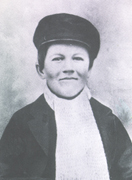 By age 12, Tom "already seemed to have become an adult." He had not only talked his parents into letting him go to work selling newspapers, snacks, and candy on the local railroad, he had started an entirely separate sideline, selling fruits and vegetables.... At age 14 - during the time of the famous pre-Civil War debates between Lincoln and Douglas - he exploited his access to the associated news releases that were being teletyped into the station each day and published them in his own little newspaper. Focusing upon such newsworthy "scoops," he quickly enticed over 300 commuters to subscribe to his splendid little paper, The Weekly Herald. Interestingly, because this was the first such publication ever to be type-set, printed and sold on a train, an English journal now gave him his first exposure to international notoriety, when it related this story, in 1860.)
back to topic After his hero, Abraham Lincoln, was nominated for president, Tom not only distributed campaign literature on his behalf, he peddled flattering photographs of this "great emancipator." (Note: Of related interest, 25 years later, Tom's strong feelings about abolition was the key factor in encouraging him to select Brockton, Massachusetts as the first place on earth to model his "World's first calibrated, perfected and standardized 3 wire, undergound central power system etc., which is fully detailed elsewhere on this website.) At its peak, Tom's mini-publishing venture netted him more than ten dollars per day. Because this was considerably more than enough to provide for his own support, he had a good deal of extra income, most of which went towards outfitting a chemical laboratory he had set up in the basement of his home. But because his, usually very patient and tolerant, mother was "worried about all the strange odors and dangerous poisons he was amassing," he transferred most of them to a locked room in the basement of his home. And placed the remainder in his locker room on the train. One day, while traversing a bumpy section of track, the train lurched, causing a stick of phosphorous to roll onto the floor and burst into flames. Within moments, the baggage car caught fire. The conductor was so angry, he severely chastised the boy and struck him with a powerful blow on the side of his head. Purportedly, this could have enhanced some of the loss of hearing he may have inherited and from a later bout he had with scarlet fever. In any case, the station-master penalized him by restricting him to peddling his newspaper to only venues in railroad stations along the track .... Remarkably, many years later, and not long after he had acquired the means to have an operation that "might have very likely restored his hearing," he flatly refused to act upon the option. His rationale was that he was afraid he "would have difficulty re-learning how to channel his thinking in an ever more noisy world." Whatever the cause for this defect, by the time Tom was 14 years of age, it was virtually impossible for him to acquire knowledge in a typical educational setting. Amazingly, however, he never seemed to fret a whole lot about the matter. Naturally inclined towards accepting his fate in life - and promptly adapting to whatever he became convinced was out of his control - he always reacted by committing himself to compensating via alternative methods....
Ultimately, Tom became totally deaf in his right ear, and approximately 80% deaf in his left ear. Poignantly, he once stated that the worst thing about this condition was being unable to enjoy the beautiful sounds of singing birds. Indeed, he loved the creatures so much, he later amassed an aviary containing over 5,000 of them. One day while he was on the train, the stationmaster's very young son happened to wander onto the tracks in front of an oncoming boxcar. Tom leaped to action. Luckily - as they tumbled away from its oncoming wheels - they ended up being only slightly injured.
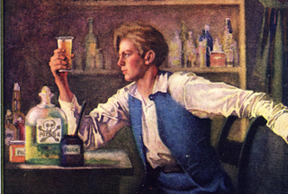 At this juncture, one of the most significant events in Tom's life occurred. As a reward for his heroism - the child's grateful father taught him how to master the use of Morse code and the telegraph. Which in the "age of telegraphy," this was akin to being introduced to learning how to use a state-of-the-art computer. Shortly after the Civil War ended, to his mother's great dismay, Tom decided that it was time to "seek his fortune." So, over the next few years, he meandered throughout the Central States, supporting himself as a "tramp telegraph operator". Not surprisingly, his "casual (same aged) friend and acquaintance" Alexander Graham Bell, who was also living and working in Boston (trying to develop a telephone-like device right along side of Edison's bench at the famous Williams Shop) was equally fascinated by this exciting new aspect of communication science. And no wonder. The principles surrounding it would ultimately lead both men toward far greater heights....
During the third week after arriving in "the big apple" Tom (seen left) was purportedly "on the verge of starving to death." At this precipitous juncture, one of the most amazing coincidences in the annals of technological history now began to unfold. Immediately after having begged a cup of tea from a street vendor, Tom began to meander through some of the offices in New York's financial district. Observing that the manager of a local brokerage firm was in a panic, he eventually determined that a critically important stock-ticker in his office had just broken down.... Noting that no one in the crowd that had gathered around the defective machine seemed to have a clue on how to fix it, he elbowed his way into the scene and grasped a momentary opportunity to have a go at addressing what was wrong, himself. Luckily, since he had been sleeping in the basement of the building for a few days - and was, typically, doing quite a bit of snooping around - he already had a pretty good idea of what the device was supposed to do. ================================================================================== It should come as no surprise that, during his free time, Edison once again resumed his habit of "moonlighting" with the telegraph, the quadruplex transmitter, and the stock-ticker, etc. Shortly thereafter, he was absolutely astonished - in fact he nearly fainted - when a corporation paid him $40,000 for all of his rights to the latter device. And if that wasn't enough to forever seal his unequaled importance in technological history, he came up with an invention that - in terms of its collective affect upon mankind - has had more impact than any other. In 1883 and 1884, while beating a path from his research lab to the patent office, he introduced the world's first economically viable system of centrally generating and distributing safe electric light, heat, and power. Sometimes properly acknowledged as his "greatest of acheivement" it has enormously impacted the world we know today... Even some of his worst critics grant that "it was a Herculean achievement that only he was capable of bringing about at this specific point in history."
By 1887, Edison was recognized for having set up the world's first full fledged research and development center in West Orange, New Jersey. An amazing enterprise, its significance is as much misunderstood as his work in developing the first practical centralized power system. Regardless, within a year, this fantastic operation was the largest scientific testing laboratory in the world.
Thomas Edison died At 9 P.M. On Oct. 18th, 1931 in New Jersey. He was 84 years of age. Shortly before passing away, he awoke from a deep coma to strains of his favorite composer, Bethoven, (Who was also deaf) that were "loudly" emanating from his favorite phonograph... Looking upward, to his very religious "ever-faithful" wife, Mina - who had been keeping a vigil all night by his side - and haltingly uttered... "I'm finished... Its very beautiful over there... Eternal GOD!
Most realized that, even though he was far from being a perfect human being - and may not have really had the always amiable and avuncular personality that was so often ascribed to him by myth makers -Thomas Edison was an essentially good man with a powerful mission. Driven by a superhuman desire to fulfill the promise of objective persistent research and create things to serve and uplift all of mankind, no one did more to help realize our founders dream of creating a brand new country that - at its best - would be seen by everyone as "a shining new city upon a hill, whose light would be going out to the world...." Because of the peculiar voids that Edison sometime evinced in areas such as cognition, speech, grammar, etc., a number of medical authorities have argued that he may have been plagued by a fundamental learning disability that went well beyond mere deafness.... A few of have conjectured that this mysterious ailment - along with his lack of a formal education - may account for why he always seemed to "think so differently" compared to others of his time: "Always tenaciously clinging to those unique methods of analysis and experimentation with which he alone alwaya seemed to feel so comfortable...." Notes: In 1929, Edison's close friend, Henry Ford, completed the task of moving Edison's original Menlo Park laboratory to the Greenfield Village museum in Dearborn, Mich. In 1962 his existing laboratory and home in West Orange, N.J. were designated as National Historic Sites.
Copyright © Gerald Beals June, 1999. All rights registered and reserved. Please Note: Absolutely no part of this publication may be reproduced or distributed in any form - or stored by any means in a database or retrieval system - without the prior written and express permission of the author. Please note: Infringements will be (in fact one is currently being) prosecuted to the full extent of the law.
gerrybeals@verizon.net
|
||||||||||
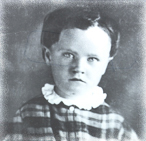
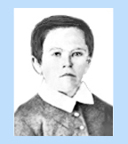 At age seven - after spending about 12 weeks in a noisy anf chaoitic one-room schoolhouse - with 38 other students of all ages and capabilties - Tom's overworked and short tempered teacher finally lost his patience with the Tom's persistent questioning and seemingly self centered behavior. Noting that his forehead was unusually broad and that his head was considerably larger than average, he made no secret of his belief that the hyperactive youngster's brains were "addled" or scrambled.
At age seven - after spending about 12 weeks in a noisy anf chaoitic one-room schoolhouse - with 38 other students of all ages and capabilties - Tom's overworked and short tempered teacher finally lost his patience with the Tom's persistent questioning and seemingly self centered behavior. Noting that his forehead was unusually broad and that his head was considerably larger than average, he made no secret of his belief that the hyperactive youngster's brains were "addled" or scrambled.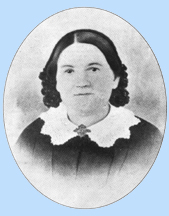
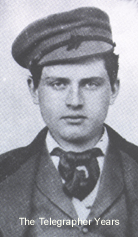
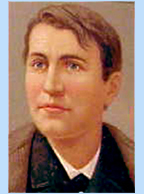
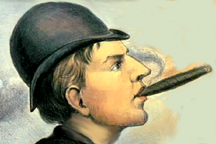
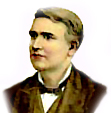 development laboratory in Newark, New Jersey.
development laboratory in Newark, New Jersey.